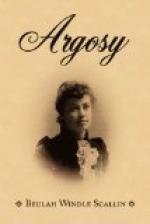As he spoke, his heavy, uninteresting face lit up as with a hidden enthusiasm, and my attention was attracted to his eyes, which I had not before noticed. They were of a curious bright metallic blue and are the only eyes I have ever seen, though one reads and hears so perpetually of them, which really seemed to flash as he warmed to his subject.
As he finished, I looked at Aunt Phoebe, who shrugged her shoulders and smiled incredulously. It was clear that she was not going to be imposed upon by his specious phrases.
It would be unnecessary to weary my readers by describing at length how the usual preliminary of choosing an unbiassed committee was gone through; nor how, after the doctor, the rector, Mr. Melton (the principal draper in Bishopsthorpe) and several other of the town magnates, all men of irreproachable honesty, had been induced to act in this capacity, the Professor proceeded, with eyes blindfolded and holding the doctor’s hand in his, to find a carefully hidden pin, to read the number of a bank-note and to write the figures one by one on the blackboard, and to perform other experiments of the same kind amid the breathless interest of the audience.
I frankly admit that I was astonished and bewildered by what I saw, and I had a little uneasy feeling that if it were not all a piece of gigantic humbug, it was not quite canny—not quite right.
What struck me most, I think, was the unfussy, untheatrical way in which it was all done. Every one of the Professor’s movements was marked by an air of calm certainty. He threaded his way through the crowded benches with such an unhesitating step that, only that I had seen the bandage fastened over his eyes by the rector and afterwards carefully examined by the doctor, neither of whom could be suspected of complicity, I should have said he must have had some little peep-hole arranged to enable him to guide his course so unfalteringly.
There were, of course, thunders of applause from the sixpenny seats when the Thought Reading part of the entertainment came to an end.
“Well, Aunt Phoebe,” I said, turning to her as the Professor bowed his thanks, “what do you think?”
“Think, my dear?” she repeated. “I think the man is a very fair conjurer.”
“But,” I protested, “how could he know where the pin was; and you know Mr. Danby himself fastened the handkerchief?”
“My dear Elizabeth, I have seen Houdin do far more wonderful things, when I was a girl; but he had the honesty to call it by its right name—conjuring.”
I had not time to carry on the discussion, for the Professor now reappeared and informed us that by far the most interesting part of the performance was still to come. Thought Reading and Mesmerism, or, as some people preferred to call it—Hypnotism—were, he believed, different parts of the same wonderful and but very partially-understood power. A power so little understood as not even to possess a distinctive name; a power which he believed to be latent in everybody, but which was capable of being brought to more or less perfection, according to the amount of care and attention bestowed upon it. “I,” said the Professor, “have given my life to it.” And again I fancied I saw the curious blue eyes flash with a sudden unexpected fire.




